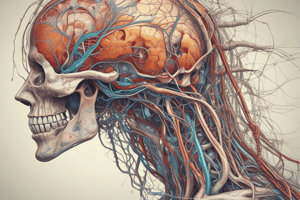Podcast
Questions and Answers
Which part of the spinal vertebrae consists of five fused vertebrae located in the pelvis?
Which part of the spinal vertebrae consists of five fused vertebrae located in the pelvis?
- Lumbar spine
- Thoracic spine
- Cervical spine
- Sacrum spine (correct)
Which type of bones primarily support the weight of the body and facilitate movement?
Which type of bones primarily support the weight of the body and facilitate movement?
- Short bones
- Long bones (correct)
- Irregular bones
- Flat bones
What is the primary function of the external intercostal muscles?
What is the primary function of the external intercostal muscles?
- Stabilize the thoracic cage
- Assist in abdominal contraction
- Primary inspiratory muscles (correct)
- Accessory expiratory muscles
Which segment of the small intestine is primarily responsible for nutrient absorption?
Which segment of the small intestine is primarily responsible for nutrient absorption?
Which of the following statements correctly describes motor nerves?
Which of the following statements correctly describes motor nerves?
Which part of the gastrointestinal tract is responsible for delivering food to the stomach?
Which part of the gastrointestinal tract is responsible for delivering food to the stomach?
What are the components of the respiratory system?
What are the components of the respiratory system?
Which group of vertebrae consists of the top seven vertebrae in the neck?
Which group of vertebrae consists of the top seven vertebrae in the neck?
What type of bones are primarily found in the wrist and ankle joints, providing support and stability?
What type of bones are primarily found in the wrist and ankle joints, providing support and stability?
Which component of the nervous system consists of the brain and spinal cord?
Which component of the nervous system consists of the brain and spinal cord?
Flashcards
Central Nervous System (CNS)
Central Nervous System (CNS)
The part of the nervous system consisting of the brain and spinal cord.
Peripheral Nervous System (PNS)
Peripheral Nervous System (PNS)
The part of the nervous system consisting mainly of nerves that connect the CNS to the rest of the body.
Sensory Nerves
Sensory Nerves
Nerves that carry signals from sensory organs to the brain.
Motor Nerves
Motor Nerves
Signup and view all the flashcards
Cervical Spine
Cervical Spine
Signup and view all the flashcards
Thoracic Spine
Thoracic Spine
Signup and view all the flashcards
Long Bones
Long Bones
Signup and view all the flashcards
Small Intestines
Small Intestines
Signup and view all the flashcards
Duodenum
Duodenum
Signup and view all the flashcards
Large Intestines (Colon)
Large Intestines (Colon)
Signup and view all the flashcards
Study Notes
Nervous System
- Two main components: Central Nervous System (CNS) and Peripheral Nervous System (PNS)
- CNS consists of brain and spinal cord
- PNS mainly consists of nerves
Spinal Vertebrae
- Cervical spine - 7 vertebrae (C1-C7), in the neck
- Thoracic spine - 12 vertebrae (T1-T12), in the upper back/rib cage
- Lumbar spine - 5 vertebrae (L1-L5), in the lower back
- Sacrum spine - 5 fused vertebrae (S1-S5), in the pelvis/base of spine
- Coccyx spine - 3-5 fused vertebrae, tailbone
Respiratory Muscles
- Intercostal muscles
- External intercostals are primary inspiratory muscles
- Internal intercostals are accessory expiratory muscles
- Abdominal muscles are accessory expiratory muscles
Bones
- Long bones: support body weight, facilitate movement, located in lower limbs
- Short bones: provide support and stability, little movement, located in wrist and ankle joints
- Flat bones: skull, thoracic cage (sternum and ribs), protect internal organs (brain, heart)
- Irregular bones: complex shapes, vary, help protect internal organs (e.g., vertebral column protects spinal cord)
Gastrointestinal Tract (GIT)
- Mouth: beginning of the digestive tract.
- Throat (pharynx): where food travels.
- Esophagus: delivers food to the stomach.
- Stomach: sac-like organ that mixes food.
- Small intestines (duodenum, jejunum, ileum): 20 feet long, involved in nutrient absorption via peristalsis.
- Large intestines (colon): 7 feet long, divided into four parts (ascending, transverse, descending, sigmoid), involved in water reabsorption.
Studying That Suits You
Use AI to generate personalized quizzes and flashcards to suit your learning preferences.
Description
Test your knowledge on the nervous system, spinal vertebrae, respiratory muscles, and the classification of bones. This quiz covers key components of the human body, focusing on anatomy and functionality. Perfect for students in biology or health sciences!




